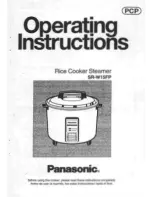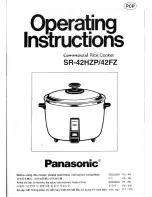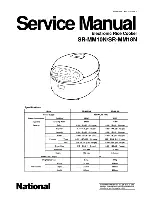
23
22
When using for the first time & on every use
O
After removing, wash with a soft sponge.
Inner Pan Rice Scoop Ladle
Inner Lid Steam
Cap
Steaming
Plate
Rice Scoop
Holder
O
After using seasoning, such as casserole, wash promptly.
(Since these can cause odor, rot, or rust)
<Do not use any of the following>
Metal scourers, nylon scourers
impregnated with an abrasive etc.
Do not wash using
the scouring pad.
Benzine, thinner, polish, bleach,
antibacterial alcohol etc.
Dishwasher/dryer or dish dryer
Lid Sensor
Cleaning
O
For cleaning, remove the Power Plug and ensure that the main body has cooled down.
O
The Packing attached to both the main body and the Inner Lid cannot be removed.
Do not pull by using excessive force or puncture with sharp-pointed objects.
(This may cause defects, delamination and damage.)
O
After washing, wipe with a dry cloth.
Lid Sensor / Pan Sensor
Wipe with a well-wrung cloth.
O
If the dirt is hard to remove, dab a mild washing-up
liquid on a nylon scourer and wipe gently.
Note
O
Using the Lid Sensor or Pan
Sensor while they are dirty may
result in the rice being burnt or
cooked in an unsatisfactory way.
Dirt on Pan Sensor
Steam Cap
Remove and rinse with water.
Make sure rice grains, dirt, or
other debris are not packed into
the Steam Cap.
O
If packed, remove with
bamboo skewers, toothpick,
or similar object.
Precautions
O
D
o not remove the Packing.
(It may cause steam to leak, or cooking contents to jet out.)
O
If the Packing came off, please surely fix it.
Fit into the groove
Press into the hole
Packing
Q
Removing
①O
Pull up to remove.
②OO
Open while pressing the
button.
Shaft
Button
Shaking makes a noise
because of the ball inside.
Q
Attaching
(In the reverse order to removing.)
①OO
Insert the shaft and close firmly until it clicks.
②OO
Attach on the Outer Lid.
(Ensure that it has been attached firmly.)
Upper Frame
Wipe with a well-wrung cloth.
O
Do not wash by pouring in water etc.
Pan Sensor
Inner Lid
Inner Lid
Remove and wash with a mild washing-up liquid.
O
Remove and wash both side of the Inner Lid.
In particular, wash the inside of the packing
carefully, as dirt can collect easily there.
(This may spoil the aroma and flavor of your meals.)
Packing
O
If the Pressure Control Hole is blocked with objects
such as grains of rice or dirt, remove them with
bamboo skewers, toothpicks or similar utensils.
(
It may cause steam to leak, or cooking contents
)
to jet out.
Pressure
Control Hole
O
Quickly push the Safety Valve 2 to 3 times with
your finger and wash with running water.
Safety Valve
Precaution
O
After cooking with seasoning (for casserole etc.),
please wash promptly.
(Since these can cause odor, rot, or rust.)
Q
Removing
①OO
Press and raise the Inner
Lid Release Clip.
(The Inner Lid tilts forward.)
②OO
Pull out.
Q
Attaching
①OO
Insert the Inner Lid into the grooves.
②OO
Press into the Outer Lid until you hear a “click”.
①
②
Grooves
Stoppers / Inner Surface of Outer Lid /
Packing / Hooks
Wipe with a well-wrung cloth.
[Stoppers / Hooks]
O
If they are blocked with objects such as grains of rice,
remove them with bamboo skewers or similar utensils.
(
Failure to do so may cause steam to jet out,
ingredients to eject out, or prevent the Outer Lid
from
opening
properly.
)
[Inner Surface of Outer Lid / Packing]
O
Remove the Steam Cap and wipe the inner surface
of the Outer Lid, the attaching portion of the Steam
Cap and the Packing.
Stoppers
Packing
Hooks
Upper Frame
Inner Pan
(P.8)
/Rice Scoop/Ladle/Steaming Plate/
Rice Scoop Holder
Wash with a mild washing-up liquid.
Precaution
O
Do not use the Inner Pan as a washing-up bowl.
(
Since this may result in
peeling of the inner coating.
)
Inner Pan
(P.8)
/ Rice Scoop / Ladle /
Steaming Plate / Rice Scoop Holder
Wash with a mild washing-up liquid.
Precaution
O
Do not use the Inner Pan as a washing-up bowl.
(
Since this may result in
peeling of the inner coating.
)
English













































